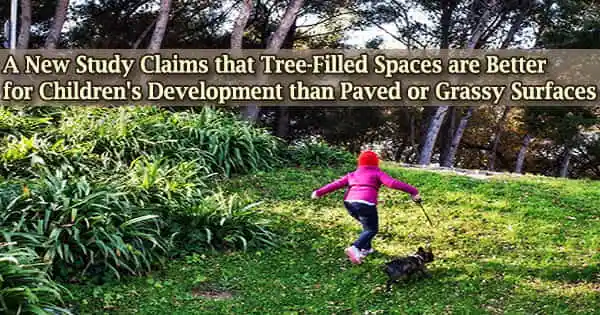Living in a tree-filled environment is connected with greater early childhood development than living in an environment with grass cover, according to a study just published in Environment International.
Both types of green space are connected with better infant development outcomes than places dominated by paved surfaces, according to the study lead by Matilda van den Bosch, senior researcher at the Barcelona Institute for Global Health (ISGlobal), a center financed by the “la Caixa” Foundation.
Green areas are linked to greater attention and memory in early childhood, higher academic achievement, and less emotional and behavioral difficulties, according to the study, which adds to a growing body of evidence.
The researchers wanted to see if the type of flora made a difference in the beneficial connections. Although all green spaces appear to enhance health, tree-filled places appear to reduce air pollution, noise, and heat better than more open green spaces, as well as supporting mental fatigue recovery and focused attention ability.
Grassy environments, on the other hand, may stimulate greater group activities and so promote social well-being. Paved surfaces, on the other hand, are linked to increased heat exposure as well as traffic-related air and noise pollution.
How the Study Was Conducted
The study was conducted in the Vancouver metropolitan area (Canada) and was based on data from 27,539 children in a large birth cohort. Various government entities, including the British Columbia Ministry of Health, collected this information between 2000 and 2005.
Because we assessed different types of vegetation, our findings contribute to an improved understanding of associations between exposure to green spaces and early childhood development.
Ingrid Jarvis
The kids were tracked from birth through age five, when their kindergarten instructors assessed their physical health and well-being, social competence, emotional maturity, language and cognitive development, communication abilities, and general knowledge. The Early Development Instrument (EDI) was used by the teachers to conduct this evaluation.
The researchers used a high-resolution land cover map to establish whether the children resided in vegetated or non-vegetated areas, as well as whether the vegetated land was grass or trees (predominantly deciduous).
The average proportion of total vegetation exposure was 36%, whereas the average percentage of paved surface exposure was 32.2%.
Conclusion
The developmental scores of children who had the most exposure to vegetation (either trees or grass) were the highest. Exposure to tree-filled environments was especially associated with a better outcome. Early exposure to paved surfaces, on the other hand, was linked to lower child development.
“Because we assessed different types of vegetation, our findings contribute to an improved understanding of associations between exposure to green spaces and early childhood development,” commented Ingrid Jarvis, a researcher at the University of British Columbia (Canada) and first author of the study.
Although more research is needed, these findings may be useful to urban planners.
“Taken together, our findings suggest that converting paved surfaces to green spaces and, in particular, increasing the amount of trees in neighbourhoods may have positive effects on early childhood health and development,” noted ISGlobal researcher Matilda van den Bosch who led the research.
Such efforts would not only enjoy the benefits of green areas, but they might also help to “minimize the negative effects of urbanization and impermeable surroundings,” she added.
Despite the fact that the connections between environmental exposure and childhood development were tiny, “even minor individual gains in childhood could translate to significant public health benefits across the life course,” according to the researchers.





